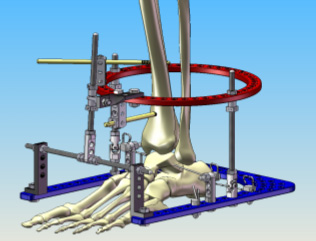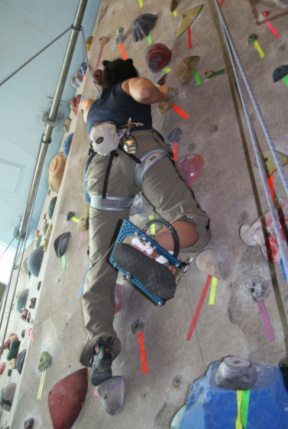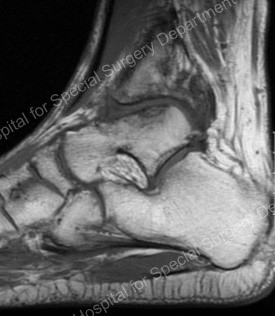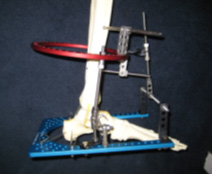Ankle Distraction Arthroplasty: Joint Restoration for Ankle Arthritis
What is ankle distraction arthroplasty?
Ankle distraction arthroplasty is an innovative procedure for treating ankle arthritis in select patients. Unlike ankle fusion and ankle replacement, distraction arthroplasty focuses on joint restoration. These other procedures, while appropriate in many cases, sacrifice the ankle joint in an effort to decrease pain from arthritis. Distraction arthroplasty uses mechanical unloading of the diseased joint to reverse the effects of arthritis and significantly lower pain without damaging the ankle joint. Additionally – and importantly – ankle motion is preserved.
This concept of joint restoration has been embraced by many foot and ankle specialists, including both orthopedic surgeons and podiatrists. Although it is relatively new in the United States, it has been performed successfully in Europe for many years. This surgery is rapidly gaining popularity, but your local orthopedist may not be aware of its benefits or may not know which centers perform this procedure.
Patient Story: A climber’s tale
Our climber is a vibrant and charismatic woman whose passions are rock climbing and the great outdoors. After sustaining a severe ankle fracture from a fall while rock climbing, her first thought was that she might never climb again. She fell from 30 feet and landed onto her right ankle, shattering the joint into many small pieces. She underwent reconstructive surgery to fix the broken bones with a stainless-steel plate and screws. Despite a valiant effort by her orthopedic doctor, she went on to develop debilitating ankle arthritis.
At 27 years old, she was unable to walk without taking frequent breaks. With no shortage of vitality she would climb at her local indoor climbing gym, but her ankle pain made it impossible to ascend more than several feet. On the days that she did manage to climb, she would be in so much pain the following day that walking around the house was a challenge. She underwent ankle arthroscopic surgery to clean out the arthritis from her joint and worked hard through several months of physical therapy. Despite these measures, her pain persisted.
Her doctors offered her an ankle fusion, a procedure that would freeze her ankle joint permanently, to relieve her pain. They warned her that her ability to climb after such a procedure would be slim to none. Her new life as a sedentary and dependent person was changing her once-positive outlook on life and was gnawing at her identity. She was desperate to regain control of her life and get back to the sport she loved. It was at this point that she came to HSS.
Here she was informed about the exciting results obtained with a novel procedure: ankle distraction arthroplasty. Soon after, she underwent ankle distraction surgery. She needed to wear an external fixator on her right ankle for 10 weeks to pull apart the joint surfaces to allow new cartilage growth. A vigorous athlete, she wasted no time in getting back into the climbing gym, even while she was undergoing active treatment.

(Figure 1: the RAD, the ankle distraction external fixator that Drs. Rozbruch and Fragomen developed at HSS specifically for this procedure)
After 10 weeks the external fixator was removed, and she transitioned into a temporary walking boot. As the weeks went by, she was able to tolerate more activity and returned to rock climbing outside. Now, 10 years after removing the device, she is able to hike for miles to her favorite climbing site, climb a sheer rock face for several hours, and then hike back out with minimal pain. The following day, she is able to do it all over again. She does not wear a brace and does not use a cane.

(Figure 2: Rock climbing while wearing the external fixator on her right ankle)
How does distraction arthroplasty work?
To understand how the procedure works you must first have a little knowledge about arthritis. Arthritis is the loss of articular cartilage (the smooth surface that covers the ends of our bones in our joints) from the joint surfaces. This is often seen as a loss of joint space on X-ray and MRI (Figure 3).

Figure 3: loss of joint space (upper center of image)
This loss of cartilage causes pain and stiffness in the joint, which is often life-altering. Arthritis also causes a hardening of the bone underneath the cartilage, which further damages the already injured cartilage cells. The exact mechanism of action of distraction at the microbiological level is not yet fully understood, but it is clear that distraction arthroplasty acts by restoring some of this lost cartilage through the body’s natural repair mechanisms.
“Distraction” is achieved by literally pulling the joint surfaces apart. This allows the dense bone underneath the cartilage to soften, revascularize, and produce a healing response. Recent MRI studies of several patients have shown dramatic regenerative tissue growth on the arthritic bone surfaces one year after the procedure (Figure 4).

Figure 4: neo-cartilage or "new" cartilage (upper center of image)
The distraction procedure
Distraction arthroplasty is a minimally invasive surgery that relies on the use of external fixation to pull the joint surfaces apart. An external fixator or “frame” is a scaffolding assembled around the leg that remains outside the body during treatment (Figure 5).

(Figure 5: An actual external fixator or "frame")
This frame is surgically applied to the ankle in the operating room under anesthesia. The rings are attached to the leg by way of pins and wires. These piercings are much like earrings, only in the skin of the lower limb. The distraction of the joint is achieved in the operating room by pulling the rings apart and then locking them. The frame has built-in hinges that allow for unrestricted ankle mobility. The distraction is typically combined with cartilage stimulating procedures as well. Most patients have bone spurs (osteophytes) that have grown in their ankle joints and often restrict motion. These spurs are removed at the time of surgery. The areas of the joint that have the worst cartilage damage are also stimulated. Microfracture technique is performed in these locations to encourage new reparative cartilage formation.
The process of neo-cartilage (“new” cartilage) tissue formation is thought to require the transformation of mesenchymal stem cells into cartilage forming cells. To speed this process, stem cells are harvested from the patient’s pelvis with a needle, which concentrates the cells, and then injected into the ankle joint. This combination of approaches provides patients with the most comprehensive treatments available today, giving them maximal benefit from the distraction procedure.
What is rehabilitation like after ankle distraction arthroplasty?
Patients are admitted to the hospital for two days, where, after surgery, they are encouraged to walk on the operated leg twice daily under the guidance of a physical therapist. Patients are discharged home with ongoing physical therapy and oral pain medication that can be taken as needed. Weight bearing as tolerated ambulation is encouraged. Daily showers to wash the leg and the fixator are a part of routine pin care. Patients are allowed to swim in a chlorinated pool as well. Ankle range of motion exercises start early and continue until the frame is removed. In most cases, the frame is worn for 10 weeks. This amount of time is needed in order to complete the slow process of tissue growth in the joint.
External fixator (frame) removal
Frame removal is performed in the operating room under sedation. This is an ambulatory procedure (you go home the same day). In the operating room, a walking boot is placed on the foot for patient comfort.
What are the risks of ankle distraction arthroplasty?
The most common problem that may develop throughout this process is pin track infection. This infection is superficial, in the skin around the pin track, and is minimized by cleaning the skin piercings daily. If a pin track infection develops, it can usually be successfully treated with oral antibiotic medications.
A distinct advantage of distraction arthroplasty is that it “does not burn any bridges.” In the event that the patient does not achieve satisfactory relief and elects to have ankle fusion or joint replacement, the boney architecture of the joint has been preserved and these subsequent procedures can still be done without increased complications.
Am I a candidate for ankle distraction arthroplasty?
Typical candidates have ankle arthritis (also called chondromalacia, osteochondritis, joint space collapse or narrowing) and still have some mobility of the ankle joint. At HSS, patients are carefully evaluated to determine whether distraction arthroplasty is appropriate. Guidelines for which patients make good candidates have been developed based on HSS surgical results that were published in the foot and ankle journal, Foot and Ankle International. The Limb Lengthening and Complex Reconstruction Service at HSS is one of the few centers in the United States that regularly performs distraction arthroplasty.
Out-of-town patients
We have a great deal of experience with treating out-of-town patients from California to Scotland and anywhere in between. Air travel is possible with the distraction frame in place and has not presented a significant obstacle to our patients or negatively impacted the results.
Updated: 7/29/2019
Authors
Attending Orthopedic Surgeon, Hospital for Special Surgery
Director, Limb Salvage and Amputation Reconstruction Center, Hospital for Special Surgery
Chief, Limb Lengthening and Complex Reconstruction Service, Hospital for Special Surgery
Director, Osseointegration Limb Replacement Center, Hospital for Special Surgery
Ankle Distraction Success Stories
References
- Bernstein M, Reidler J, Fragomen A, Rozbruch SR. Ankle distraction arthroplasty: indications, technique, and outcome. J Am Acad Orthop Surg. 2017 25(2):89-99.
- Tellisi N, Fragomen A, Kleinmann D, O’Malley MJ, Rozbruch SR. Joint Preservation of the Osteoarthritic Ankle using Distraction Arthroplasty. Foot Ankle Int, 2009 Apr;30(4):318-25.
- Ploegmakers JJ, van Roermund PM, Van Melkebeek J, et al. Prolonged Clinical Benefit from Joint Distraction in the Treatment of Ankle Osteoarthritis. Osteoarthritis Cartilage, 2005 Jul;13(7):582-8.
- Marijnissen AC, van Roermund PM, van Melkebeek J, et al. Clinical Benefit of Joint Distraction in the Treatment of Severe Osteoarthritis of the Ankle: Proof of Concept in an Open Prospective Study in a Randomized Controlled Study. Arthritis Rheum, 2002 Nov;46(11):2893-902.
- Inda JI, Blyakher A, O'Malley MJ, Rozbruch SR. Distraction Arthroplasty for the Ankle Using the Ilizarov Frame. Tech Foot Ankle Surg, 2003; 2(4):249-253.



